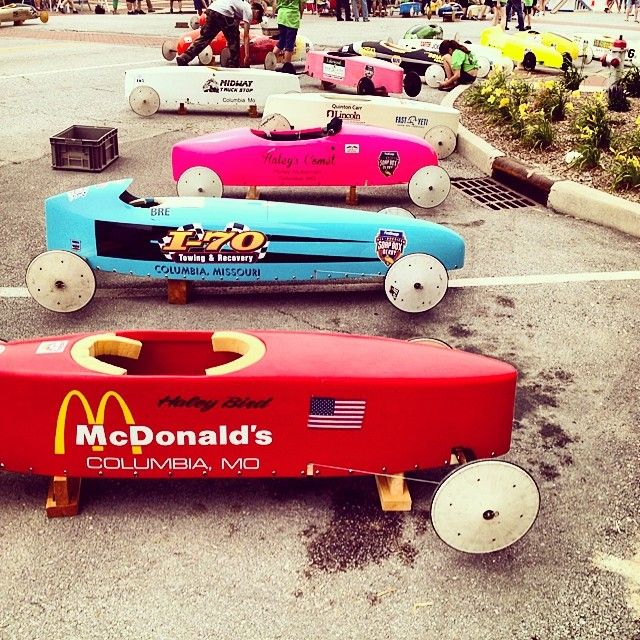Carl Fisher was born in Indianapolis in 1874. Not today; his birthday was in January. He joined in the bicycle craze of the late 1800s and opened a bike shop. By the early 20th century the shop was doing pretty well, and Fisher’s new enthusiasm was for those new horseless carriages.
He saw a big future for the horseless carriage, and in 1904 bought the rights to the patent for manufacturing acetylene headlights. Electric headlights were at least a decade away at the time, and before long his new Prest-O-Lite company was supplying headlights to most of the car builders springing up all over the country.
Quite a few manufacturers were appearing right in his home town, and around 1907 he declared “Indianapolis is going to be the world’s greatest center of horseless carriage manufacturer, what could be more logical than building the world’s greatest racetrack right here?”
His idea for the racetrack came from a trip to Europe. He discovered that European cars were quite a bit more advanced than those in the US, and he thought it was partly due to racing on the banked, oval racing tracks he saw there — particularly the Brooklands track, outside of London. The track has been (mostly) gone for decades, but there’s now a famous aviation and automobile museum there.
Fisher formed a partnership in 1908 — the Indianapolis Motor Speedway Corporation — and they started construction the next year. It was an oval, banked in the corners so the racers could go faster, and with plenty of grandstands for spectators. They opened the grounds for the first race on …no, not August 19th. The first race was June 5, 1909. But the track wasn’t finished yet. The first race was a balloon race.
The first race on the track itself was in August. But no, not the 19th. On August 14, 1909, there was a motorcycle race. But it was cut short because they realized the track surface wasn’t suitable. It wasn’t paved in the modern sense; it was crushed stone with oil poured on top. Not the greatest for motorcycles. Maybe the worst possible, in fact.
August 19, 1909 was when the first automobile race was held at the Speedway. The car drivers weren’t particularly happy about the surface either; both they and their cars got covered with dirt and oil, and the cars kicked up stones that in at least one case broke a driver’s goggles (the driver, by the way, was Louis Chevrolet, who years later had a car brand named after him).
Over the three days of racing, one driver, two mechanics (every car had a mechanic riding along), and two spectators were killed in crashes, and it was all blamed on the track surface. They had to do something better. But in 1909 “paved roads” were a brand-new idea and there wasn’t any consensus (or expertise) about how to do it.
After some tests, they settled on bricks. The track was 2.5 miles long, and it took 3.2 million bricks — each one laid by hand. The track reopened in December 1909 and got the nickname it still has: The Brickyard. The bricks were eventually covered by modern pavement, but there’s still a 3-foot-wide section of brick at the start/finish line.
Auto racing, like the Indy 500, captured the imaginations of kids throughout the country, who wanted a turn too. By 1914, there was even a silent movie called Kid Auto Races at Venice. It was quite a hit; it was the film Charlie Chaplin used to introduce his Little Tramp character. It was filmed at a real-life race, the Junior Vanderbilt Cup in Venice, California. Some of the entrants were gravity-powered, and raced down a slope.
Engines were expensive (and mostly still are) and gasoline was dangerous (and definitely still is), so homemade gravity-powered race cars were a pretty common project for kids and dads. You could start with a wooden shipping crate, add some wheels and a seat, and you were all set to go. By the 1930s, some of the races were starting to get more organized, and in 1933 — on August 19, in fact — a big race with actual prize money was held in Dayton, Ohio. It was the first running of the Soap Box Derby. It’s still going; there are competitions all over the place leading up to the national finals in Akron.
But nobody uses shipping crates any more. Most people start building their Soap Box Derby racer by buying a kit from the All-American Soap Box Derby Association — it comes with a sleek fiberglass body. They even look like real racing cars like the ones you can see at the museum at The Brickyard, and even the one at the site of the old Brooklands track in England. The Brooklands collection includes street cars, racing cars, motorcycles, and historic airplanes. But no soap box derby cars; that kind of racing never spread beyond the US.

